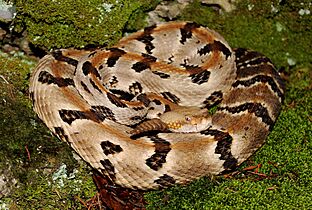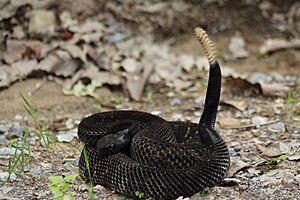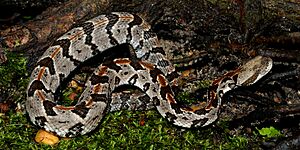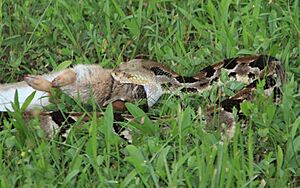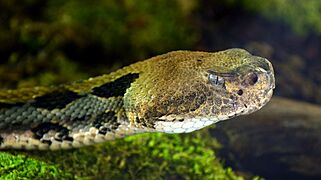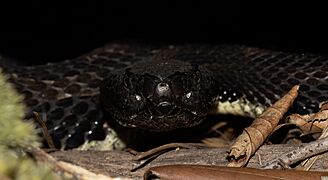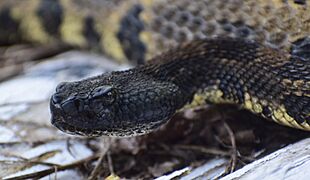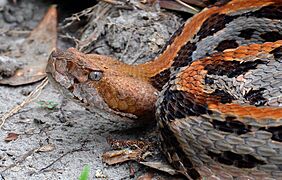Timber rattlesnake facts for kids
Quick facts for kids Timber rattlesnake |
|
|---|---|
 |
|
| A timber rattlesnake in its natural home | |
| Conservation status | |
| Scientific classification | |
| Genus: |
Crotalus
|
| Species: |
horridus
|
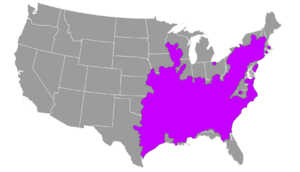 |
|
| Where timber rattlesnakes live | |
The timber rattlesnake (Crotalus horridus) is a type of venomous pit viper found in the eastern United States. It's also known as the canebrake rattlesnake or banded rattlesnake. This snake is famous for its rattle, which it shakes to warn others. It's the only rattlesnake species in many parts of the northeastern U.S. and is one of the most northern venomous snakes in North America.
Contents
- Discovering the Timber Rattlesnake
- What's in a Name?
- What Does a Timber Rattlesnake Look Like?
- Where Do Timber Rattlesnakes Live?
- How Timber Rattlesnakes Behave
- The Timber Rattlesnake Life Cycle
- What Do Timber Rattlesnakes Eat?
- Understanding Timber Rattlesnake Venom
- A Symbol of American History
- Protecting Timber Rattlesnakes
- See also
Discovering the Timber Rattlesnake
The famous scientist Carl Linnaeus first described the timber rattlesnake in 1758. He gave it the scientific name Crotalus horridus. This name has stayed the same ever since!
Scientists group animals to understand them better. The timber rattlesnake belongs to a group called Crotalus. These snakes have small scales on their heads. This helps scientists tell them apart from other similar snakes.
What's in a Name?
The name Crotalus comes from Latin. It means "a rattle" or "to rattle," like the sound of castanets. This makes sense because of the snake's famous tail rattle!
The word horridus also comes from Latin. It means "dreadful" or "horrid." This likely refers to its powerful venom. Sometimes, people still call southern populations "canebrake rattlesnakes." The word "canebrake" refers to thickets of cane plants where they live.
What Does a Timber Rattlesnake Look Like?
Timber rattlesnakes are medium to large snakes. Adults usually grow to be about 91 to 152 centimeters (3 to 5 feet) long. Some very large ones have been found to be almost 189 centimeters (over 6 feet) long! Most adults weigh between 500 and 1500 grams (about 1 to 3 pounds).
These snakes have special scales on their backs called dorsal scales. They are ridged, or "keeled," and arranged in rows. Their bellies are usually yellowish.
Their bodies have a cool pattern. They are often yellowish-brown or grayish with dark brown or black bands across their backs. These bands often have zig-zag edges and can look like V or M shapes. Some snakes even have a rust-colored stripe down their back.
Many timber rattlesnakes are very dark, almost completely black. This is called melanism. Their tails are always black and feel "velvety." This black tail is a key feature!
- Four color variations of timber rattlesnakes (''Crotalus horridus'') from one Missouri county
Where Do Timber Rattlesnakes Live?
Timber rattlesnakes live in the eastern United States. You can find them from southern Minnesota and New Hampshire, all the way south to East Texas and North Florida.
Sadly, these snakes used to live in southern Ontario and Quebec in Canada. But they are no longer found there. In May 2001, Canada listed them as "extirpated," meaning they are gone from that region.
In the past, many timber rattlesnakes lived in places like Iowa and Massachusetts. For example, in the 1800s, a town in Massachusetts even paid people to clear a hill of snakes! Today, their numbers are much smaller in many areas.
These snakes love deciduous forests, which are forests where trees lose their leaves in autumn. They prefer rugged areas. You might find them in lowland cane thickets, around swamps, in pine forests, or in mountainous regions.
During summer, female snakes that are going to have babies like sunny, rocky spots. These are called "basking knolls." Males and other females often stay in cooler, denser woods.
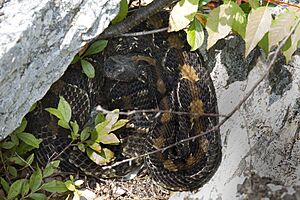
How Timber Rattlesnakes Behave
Timber rattlesnakes are interesting creatures! In winter, they go into a deep sleep called brumation. They hide in dens or cracks in rocks, often with other snakes like copperheads (Agkistrodon contortrix) and rat snakes (Pantherophis alleghaniensis, P. obsoletus, and P. spiloides).
These snakes are very loyal to their winter homes. They tend to return to the same den every year. Studies show that rattlesnakes from the same den, especially young ones and pregnant females, are often related. This might be because young snakes can follow scent trails from their family members. Sometimes, they even come out of their dens for a short sunbath in the middle of winter!
The Timber Rattlesnake Life Cycle
Female timber rattlesnakes usually have their first babies when they are about 9 or 10 years old. They don't have babies every year. On average, they have a litter of about 7 or 8 babies every four years. Many females only reproduce once in their lifetime.
Young timber rattlesnakes look like smaller versions of the adults.
What Do Timber Rattlesnakes Eat?
Timber rattlesnakes are carnivores, meaning they eat other animals. Their main food is small mammals. This includes mice, rats, squirrels, and rabbits. They might also eat small birds or frogs.
Like most rattlesnakes, they are clever hunters. They use their sense of smell to find good places to wait for prey. They often strike their prey quickly and then follow it until they can eat it.
Sometimes, they use fallen logs as a hiding spot. This gives them a good view to strike at animals passing by on the ground. Even if their prey, like squirrels, are in trees, the snake might wait patiently at the base of the tree for them to come down.
Young rattlesnakes eat smaller prey, such as shrews. But both young and adult snakes love to eat mice.
Understanding Timber Rattlesnake Venom
Timber rattlesnakes are venomous, meaning they can inject a special liquid called venom. This venom helps them catch their food. Because of their size and long fangs, their bite can be serious.
However, these snakes are usually quite calm. They often give many warnings before they strike. They will rattle their tail loudly and might even make a few fake strikes first. If you hear a rattle, it's a clear sign to back away slowly and give the snake space.
If someone is bitten by a timber rattlesnake, it's very important to get medical help right away. Doctors can use a special medicine called CroFab antivenom to treat the bite.
A Symbol of American History
The timber rattlesnake has a special place in American history! In 2008, it became the state reptile of West Virginia. Students from Romney Middle School helped make this happen!
During the American Revolution, this snake became a powerful symbol of American strength and determination. People in the 1700s didn't know much about treating snakebites, which made the snake seem even more fearsome.
You might have seen the coiled rattlesnake on the famous Gadsden flag. This flag has the motto "Don't Tread on Me" and was used by early American colonists. It's still a symbol today for ideas like freedom and individual rights.
Protecting Timber Rattlesnakes
Even though timber rattlesnakes are widespread, their numbers are shrinking in many places. The IUCN Red List currently lists them as "least concern." This means they are not immediately in danger globally.
However, in many parts of the United States, especially in the northern areas, they are in trouble. They have disappeared from many places where they once lived. For example, they are listed as endangered in states like New Jersey, Ohio, Vermont, Connecticut, Massachusetts, Virginia, Indiana, and New Hampshire. They are threatened in Illinois and New York.
In Massachusetts, these snakes were once very common. But today, they are rarely seen and are considered endangered. It's against the law to harm, kill, or collect them there.
Sadly, timber rattlesnakes are no longer found in Maine and Rhode Island. Only one small group remains in New Hampshire. Protecting their habitats and understanding these snakes is very important to help them survive for future generations.
- Closeup of the heads of four ''Crotalus horridus''
See also
 In Spanish: Cascabel de los bosques para niños
In Spanish: Cascabel de los bosques para niños
- Snakebite




